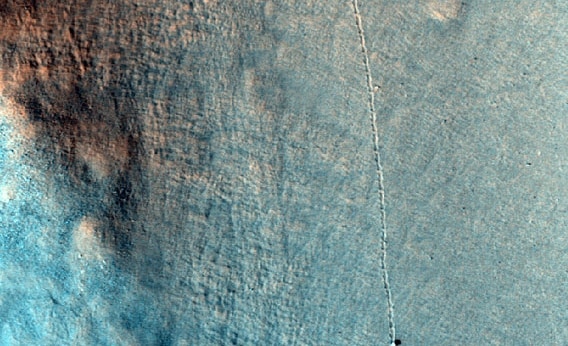Create a free profile to get unlimited access to exclusive videos, sweepstakes, and more!
Martian Rock 'n' Roll

I love Mars.
That wasnât always true. Iâm more of an explodey star guy, so to me, a few years back, Mars was an interesting place but ultimately just a rest stop on the way to looking at more fun objects.
But familiarity breeds respect. Once NASA and other space agencies started putting high-resolution cameras orbiting the red planet, things got a lot cooler there for me. The more I looked, the more fascinating Mars got.
What I like best on Mars are those things that show change. Dunes migrating, new craters, avalanches, dust devils. But for some reason, just about my all-time favorite of all of these are rolling rocks: boulders that have been dislodged and thumped their way downhill to some resting spot.
The folks behind the fantastic HiRISE camera just released a great example of this, a boulder that careened down a slope in the Nili Fossae region:
[You should click that to embiggen it; the track is much clearer in the higher-res version.]
[UPDATE (June 8, 2013 at 16:00 UTC): Out of the blue (harhar) I suddenly realized I never mentioned that this is a false color, enhanced image; the region is actually ruddy and butterscotch colored. I hope the blue hue didn't throw anyone!]
Fossa (plural: fossae) is the name given to a long trench of unknown originâtrenches are a common geologic feature, like arroyos and gullies from flowing water, or rilles from flowing lava. Nili Fossae are a collection of such trenches not too far from the Isidis basin on Mars, a huge impact structure 1500 kilometers across. The fossae may be stress fractures from the impact; features sometimes called grabens. Mineralogical studies of the area show it to contain clay minerals, which means there was water there once upon a time. The Nili Fossae area was in consideration for the landing spot for Curiosity, in fact, but Gale Crater won out.
But enough of the technical stuff! I want to point out first that the fact that a boulder rolled down a slope on Mars is pretty interesting all on its own. What started it up? A Marsquake, a nearby impact, the erosion of its underpinning due to the relentless Martian winds?
You can see the boulder at the bottom of the image, its shadow stretching off to the upper right. The rock is not quite large enough to clearly see any shape or features on it; itâs probably only a few of meters across.
But as I looked at the image, I noticed something. Hereâs a close-up:
The track of the boulder in the Martian surface is not continuous, but broken up into short segments. I added the arrows, pointing to a little ridge between each segment. Look again at the big version and youâll see this pattern repeated dozens of times.
This tells us something about the shape of the boulder: itâs not perfectly round. There must be a bump on it, big enough that as it rolled it pushed the rock up, over the surface, then plopped it back down. Itâs possible the rock was airborne for a moment as it rolled every time the bump contacted the ground, but if the motion was slow and the bump big enough, it would simply be lifted up a bit, literally leveraged above the surface, before coming back down. So it was either hopping or clomping its way down the slope.
There are a few other rock tracks to the right as well, and they too have this feature. Some of the gaps are pretty wide in those tracks, clearly showing those rocks were hopping as they fell. Itâs not surprising, of course; no rock is a perfect ball, and we see this not just on Mars but on the Moon and even the Earth as well. But itâs still pretty nifty.
In fact, the big track wiggles a bit and thickens and thins over each segment, revealing more structure of the rock. I imagine thereâs a way to unravel this information to generate a three-dimensional map of the rock, at least over the strip that contacted the ground as it rolled. I canât for the life of me think how this would be useful. But it would be a fun mathematical exercise.
By the way, thereâs one more thing I canât resist mentioning. I first found this picture linked from the @HiRISE Twitter feed. And where did they post the actual picture?


























